The first time you see it, you wonder, “Is that . . . ?” You’re pretty sure it is, especially if you get the version with the flies buzzing around it. Then, you try to interpret its meaning. This is where emoji meanings come in. What could this person be trying to tell you with a poo’ emoji?
And, yes, it is poo’ that I prefer to spell and say. The apostrophe replaces the final p here the way some people leave the final g off of words like livin’ and dyin’ and so forth. Like you and everyone else, I know what it is. I just choose to say it and spell it my way. It feels better to me, and how we feel about ourselves matters a lot, right?
What Makes It an Emoji?
Before getting into what the poo’ emoji really means and how we should take it when someone sends it to us in a chat message or email, we are going to make sure we all know the difference between emoticons, smileys, and emoji.
Emoticons
Strictly text symbols, emoticons are mankind’s earliest attempt at succinctly expressing an emotion or attitude without writing it out fully. There is even a theory that Abraham Lincoln used one to convey a wink in a notation to one of his speeches.
An emoticon can appear within text without drawing much attention to itself, like this simple smile, : ) or this angry but sad one, >:’( . You can’t miss that it’s there, but it doesn’t interrupt the flow of the text. People will sometimes employ a character or two from an alternate keyboard to create a more elaborate emoticon, but the ones most often used and best understood are kept to the characters we use all the time.
Smileys
A smiley can cross the boundaries between emoticon and emoji, but it its own all the same. Smileys will always be a face, while emoji include non-facial and even inanimate objects. The most basic emoji are often called smileys, as are the small animated .gifs used on message boards, like the ones below.
| |
Emoji
The broad definition of emoji is a small artistic representation of a thought, object, mood, emotion, or intent. It is not necessarily a face but can be just about anything.
If you’ve ordered a pizza but everyone is scattered around the house by the time it gets there, send a pizza emoji in a group text and they’ll all know to run to the kitchen. Is someone running a little late for an appointment or is a teen out past curfew? Send them a clock emoji or perhaps even better, an hourglass. For more emphasis, send a finger pointing in its direction.
Congratulate someone with a bouquet of flowers or a beer emoji. Doing your nails and can’t text? Carefully press the keypad to send a nail polish emoji and they’ll understand.
If you are not yet practiced at the art of emoji, you may want to get on that particular task sooner rather than later. Emoji have infiltrated our language and are no longer used only by teens. The Oxford Dictionary named “face with tears of joy” its 2015 “word” of the year. Funny that a dictionary would do that when there is no official dictionary of emoji, though several good attempts to fill that void are online and I’ll tell you about them later.
What Emoji Means
While some are obvious, there are plenty of examples where the meaning of an emoji is quite often totally in the mind of the sender. Usually it’s pretty easy to understand. A heart is love, while a broken heart is sad. Same with a smile – it shows happiness, agreement, or support.
You might wonder, though, what to make of an emoji with a smile and a tear, or an open mouth and a tear. Or, why did your date last night send an emoji with a tongue sticking out when you asked how she liked your ziti? There are subtle differences, and those little details matter when trying to interpret an emoji you have not seen before now.
In the example below, the emoji with a tongue to the side is savoring something just eaten. The closed mouth (for we chew with our mouths closed) and eyes emphasize the meal is being enjoyed.
The emoji with a tongue down the middle with his mouth open (so we know that he cannot be eating) and cockeyed eyes is saying something else.
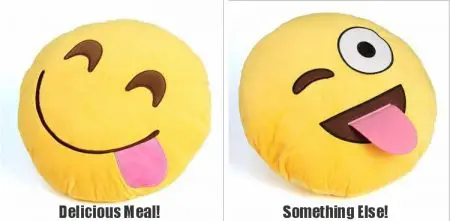
The Poo’ Emoji
Emoji come from Japan, and the meanings we attach to an emoji is often quite different from the meaning it has to its Japanese originators. Such is the case with the poo’ emoji.
According to Takeshi Kishimoto, the Japanese product manager at Google who lobbied for the character when the tech giant was deciding what to include in the first essential collection they would launch, the poo’ emoji means, “’I don’t like that,’ but softly” to its Japanese users.
Kishimoto lobbied for the inclusion of what is known as the “unchi” emoji in Japan saying that any basic emoji set would be incomplete without it, referring to unchi (poo’) as, “the most useful emoji.”
Yes, it seems that the poo’ or unchi emoji is absolutely essential to the Japanese, and excluding it from an emoji collection has been compared to leaving our letter “b” out of the alphabet.
In the same interview, Kishimoto revealed that the word emoji comes from the Japanese word for image, which is “E,” and “moji,” which means character. He also told the interviewer that women in Japan feel that an email with no emoji is, “dry, dry, dry mail.” Adding a few of the character makes it seem more personal, adding some emotional context and “softening” the words.
That would seem to put to rest any rumors that the poo’ emoji is instead really a chocolate ice cream emoji, though some of us would much prefer to think of it that way.
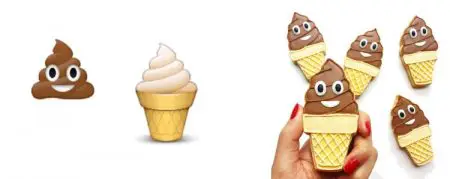
Deciphering Other Emoji
Before we send one of the more creative emoji in an email or text message, we should be sure that we understand what it means. The same goes for when we receive one, because if we do not make sure of the meaning there could be a big misunderstanding between the sender and us.
Lucky for us, there are several resources available to help us check that emoji and make sure we are responding with the right one. I will tell you about two that are online and one of the apps you can use to define an emoji.
Emoji Keyboard
The neat thing about the online emoji keyboard is that it helps you to know what each emoji is plus will compose your emoji message for you. Choose a tab for the category of emoji – people, objects, animals, food, etc. – and the total array of characters within that category appears.
As you hover over each one, the meaning or explanation for it appears at the top of the gallery. When you click, it pops into the message area at the top of the page. If you want to send what you’ve put together there, just copy and paste it into your email or messenger screen and send it.
The features on the site work great on your computer’s web browser, but when you use it on your smartphone you will lose the ability to hover for a description. The copy/paste still works, though, as well as the sort and the galleries.

Emojipedia
When you want to dig a little deeper into the information on that emoji, Emojipedia might be the best source. From the landing page, you can sort through emoji by keyword using the search bar or by clicking on a category lower down on the page.
When you enter into a gallery page, every emoji for the category you chose is viewable. Click on the one you want to explore, and you go to a page that is all about that emoji.
First, you get the emoji’s name with a description of its appearance and components. When it is similar to another emoji, the page might explain the subtle difference between the two.
On down the page, you are shown how the emoji is presented in each of the most popular places you will see or use it. That’s right – just about every phone or app will render the same emoji a little differently from the rest.
After that, Emojipedia gives you the shortcut and code for the emoji (in case you’re ever wanting to text one without an emoji keyboard handy) along with links to social media pages for the character and a list of similar emoji in case this one isn’t just right for the moment.
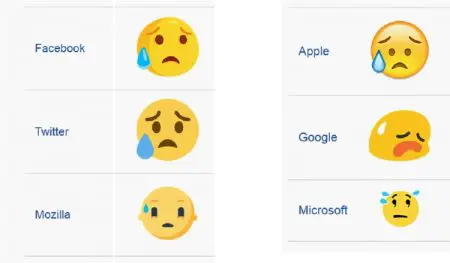
Emoji Chooser
You can tell by a quick look at it in the app store that this is not among the most popular emoji keyboard type apps out there, but it has one of the highest ratings from users, and I like it, too.
Emoji Chooser does what you would expect of any emoji keyboard. It lets you choose your emoji and then send them in just about any social chat app you choose. The app does not assume that you know what each emoji is, so it tells you.
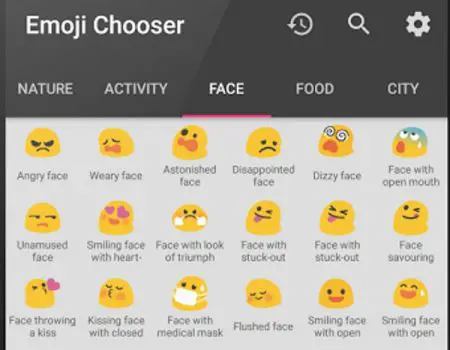
Emoji Copy and Paste Trick
On your journey to emoji stardom, you may find a little emoji copy and paste trick helpful. It will allow you to insert your chosen emoji where you want when you want. Check it out!
Classic Emojis
The classic emojis are the original set of 176 emojis that were created by Japanese artist Shigetaka Kurita in 1999 for the first mobile phone operator in Japan, NTT DoCoMo. These emojis were designed to convey a range of emotions and ideas in a simple and intuitive way, and they quickly became popular in Japan and around the world.
Here are some examples of classic emojis:
- 😀 – This is the classic smiling face emoji, which is used to convey happiness, joy, or positive emotions.
- 😂 – This is the classic face with tears of joy emoji, which is used to express laughter or amusement.
- 😍 – This is the classic heart eyes emoji, which is used to express love, admiration, or attraction.
- 😊 – This is the classic smiling face with smiling eyes emoji, which is used to express happiness or contentment.
- 😎 – This is the classic cool face emoji, which is used to express confidence, coolness, or a laid-back attitude.
- 🤔 – This is the classic thinking face emoji, which is used to express contemplation or confusion.
- 🤷 – This is the classic shrugging person emoji, which is used to express uncertainty or a lack of knowledge.
The classic emojis have since been expanded and updated with new emojis being added to the Unicode standard each year. However, the original set of 176 emojis still holds a special place in the history of emoji and remains popular among users today.
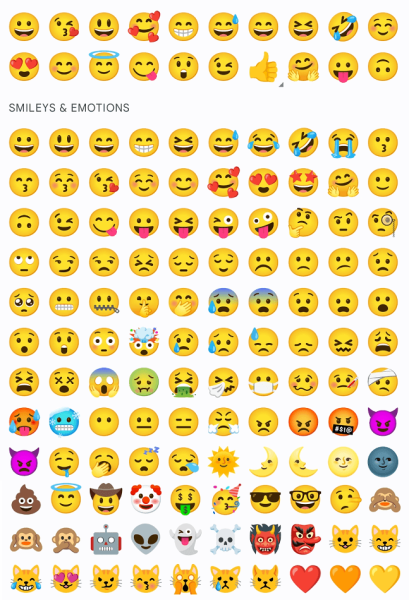
Grinning Face Emoji
The grinning face emoji 😀 is one of the most commonly used emojis and is easily recognizable by its broad smile and slightly squinted eyes. This classic emoji has a wide grin and is often used to express happiness, amusement, or excitement.
Let’s say you just got some exciting news, like finding out that you got accepted into your dream school. You might send a message like: “OMG! I just got accepted into my dream school! 😀🎉🙌.”
In this case, the grinning face emoji conveys a sense of excitement and by pairing it with other celebratory emojis like the party popper and the raised hands, you’re showing that you’re thrilled and want to share your excitement with others.
Smirking Face Emoji
The smirking face emoji 😏 is a popular emoji that features a sly, suggestive expression. It is typically depicted as a yellow face with raised eyebrows, a closed smile, and a small smirk on one side of the mouth.
Let’s say you’re having a conversation with a friend about a new hobby you just started, but you’re not very good at it yet. You might send a message like: “I just tried playing guitar for the first time and my fingers are so sore 😅😏.”
In this case, the smirking face emoji helps to convey a sense of humor and playfulness. By pairing it with the laughing face emoji, you’re indicating that you’re not taking yourself too seriously and that you’re able to laugh at yourself. The smirking face emoji can also be used to convey a sense of mischief or teasing, so in this case, it might suggest that you’re jokingly implying that you’re already a pro at playing guitar, even though you just started.
Smiling Face Emoji
We’ve all used this cute emoji a gazillion times! The smiling face emoji 😊 is a simple yet versatile classic emoji often used to convey happiness, positivity, or friendliness. It is typically depicted as a yellow face with a broad, closed smile and two open eyes.
Snapchat Emoji Meanings
Snapchat emojis use a number of emojis to represent different features, actions, and statuses within the app. Check out the following snapchat emoji meanings:
- 😊 Smiling Face: This emoji appears next to a friend’s name when you are both best friends, meaning you snap each other the most.
- 💛 Yellow Heart: This emoji appears next to a friend’s name when you are each other’s best friend, meaning you both snap each other the most.
- ❤️ Red Heart: This emoji appears next to a friend’s name when you have been each other’s best friend for two weeks in a row.
- 💕 Pink Hearts: This emoji appears next to a friend’s name when you have been each other’s best friend for two months in a row.
- 😎 Sunglasses Emoji: This emoji appears next to a friend’s name when you have a mutual best friend, meaning you both snap the same person the most.
- 😬 Grimacing Face: This emoji appears next to a friend’s name when you both have a mutual best friend, but you are not each other’s best friend.
- 🔥 Fire: This emoji appears next to a friend’s name when you have been on a snapstreak with them for at least three consecutive days.
- 💯 Hundred: This emoji appears next to a friend’s name when you have sent and received snaps with them for 100 days in a row.
- 🎂 Birthday Cake: This emoji appears next to a friend’s name on their birthday.
- 🌟 Gold Star: This emoji appears next to a friend’s name when their snap has been replayed at least once.
Let’s say you use Snapchat to communicate with a friend frequently. If you both exchange snaps back and forth consistently for a certain period of time, you might notice that a fire emoji appears next to your friend’s name on your friend list. This fire emoji indicates that you and your friend have been on a “snap streak,” meaning that you’ve both sent snaps back and forth for a consecutive number of days.
Another example of Snapchat emojis is the heart emoji. If you and a Snapchat friend have been sending snaps to each other frequently and consistently for a certain period of time, a yellow heart emoji might appear next to their name on your friend list. This yellow heart indicates that you and your friend are best friends on Snapchat, meaning that you send the most snaps to each other compared to anyone else on your friend list.
There are many other Snapchat emojis that can appear next to your Snapchat friends’ names, such as the smiling face emoji, the grinning face emoji, and the sunglasses emoji, each with its own specific meaning.
Pouting Face Emoji
We all know this one. Sigh. Use the pout face when you’re having a bad day or something is not quite right. It generally means something is not going your way.
The pouting face emoji 🙁 is a popular emoji that features a face with a displeased or sulky expression. It is typically depicted as a yellow face with a small, downturned mouth and furrowed eyebrows.
Let’s say you’re feeling disappointed that a friend cancelled plans that you were looking forward to. You might send a message like: “Aww, I was really looking forward to seeing you today. 😞”
Sad But Relieved Face Emoji
The sad but relieved face emoji 😔😌 is a unique emoji that features a face with two emotions: sadness and relief. It indicates ambivalence and a feeling of sadness but at the same time relief.
Let’s say a friend of yours was really worried about an upcoming exam. After the exam, your friend felt disappointed at the results. You might respond with a message that includes the sad but relieved face emoji to show that you understand the disappointment, but are also relieved that it’s over and that they can move on.
For example, you could send a message like: “I’m sorry to hear that the exam didn’t go well, but at least it’s over now 😔😌.
Fire Emoji
The fire emoji 🔥 is a popular emoji that is often used to convey a sense of excitement, energy, or intensity. It is typically depicted as a flame, often colored orange or red, with a flickering shape that suggests movement.
Let’s say you and a friend have been sending snaps back and forth for five days in a row. You might send a message like: “Wow, we’re on a five-day snap streak! 🔥🔥🔥”
Clapping Hands Emoji
The clapping hands emoji is a popular way to express applause or appreciation for someone or something. It is often used to show support, admiration, or congratulations and is often paired with other emojis or text to emphasize the positive sentiment behind the message.
Here’s an example of how someone might use the clapping hands emoji in a message:
“Congratulations on your new job! 👏👏👏 You deserve it!”
Birthday Cake Emoji
The birthday cake emoji is a colorful representation of a cake with lit candles on top, often used to celebrate someone’s birthday or a special occasion.
“Happy birthday! 🎂🎉 Hope your day is filled with lots of love, laughter, and of course, cake!”
History: The First Emoticon
Scott Fahlman is credited with creating the first emoticon, which is a precursor to the modern emoji. Fahlman was a computer scientist and professor at Carnegie Mellon University in the early 1980s, when he came up with the idea of using a combination of keyboard characters to convey emotion in text messages.
Specifically, Fahlman proposed using 🙂 to represent a smiley face, and 🙁 to represent a frown or sad face. He suggested that this could help to clarify the tone of written communication, which can be difficult to discern without nonverbal cues like facial expressions and tone of voice.
Now is this guy cool or what? Computer scientists are not usually associated with conveying feelings or emotions, but this guy did it.
Fahlman’s idea caught on quickly, and the use of emoticons became increasingly popular in online communication. While emoticons are now somewhat outdated, they paved the way for the more sophisticated and visually appealing emoji that we use today. Occassionally, however, you find yourself in an editor in which emojis can’t be inserted, so using the old keyboard emoji signals comes in handly!
Popular Emoticons
These are without a doubt the most popular text emoticons.
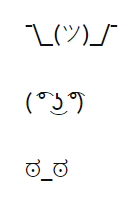
- The first is the shrug emoticon and indicates confusion or cluelessness.
- The second is the the Lenny face which is used to convey humor or sarcasm.
- The third is called the look of disapproval emoticon. It expresses skepticism or disbelief towards something.
Happy Emoticons
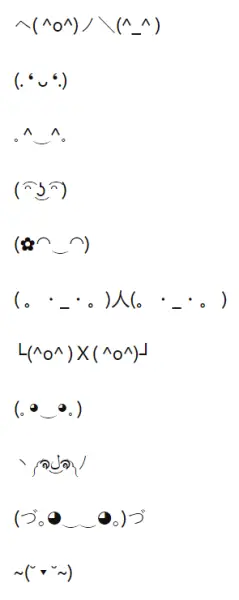
Angry Emoticons
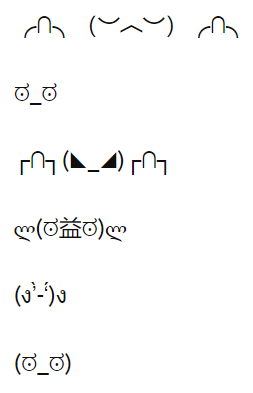
Animal Emoticons
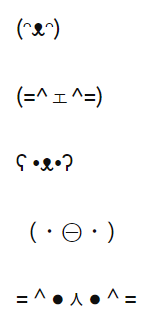
Table Flipping Emoticons
Table flipping text emoticons, also known as table flip emoticons, are a type of emoticon that depict someone flipping over a table in frustration or anger.
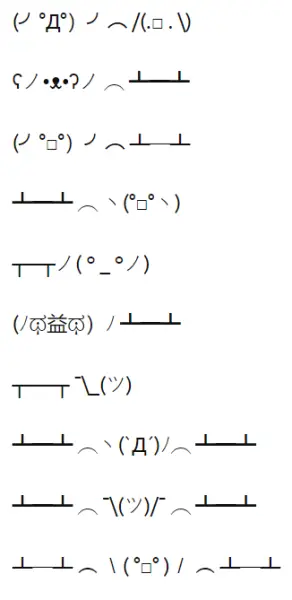
WTF Emoticons
WTF text emoticons are used to convey surprise, shock, confusion, or disbelief in response to something unexpected or outrageous.

As emoji continue to infiltrate our language, understanding the different meanings of each one will be more important to us. The information here hopefully gives you a good start on where to study up so that ‘speaking’ emoji is soon a natural for you, too.
